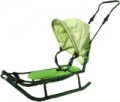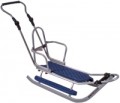—
Back. Classic backrest — a device that provides additional support for the back and reduces the likelihood of falling backwards. The backs can have a different design, in some models they are made folding or removable — this is useful for those who like to sled lying down, head first. Also note that the height of the backrest can be different — sometimes it is purely symbolic; so if a full-fledged back is important to you, you should pay attention to the appearance of the selected sled.
— Steering. Steering usually takes the form of a separate ski, turned with a steering wheel. This feature is almost mandatory for snowshoes, it is also found in some one-piece sleds (see "Type"), but in other varieties it is practically not used. Note that the use of steering alone does not guarantee efficiency in corners — especially at high speed; so when manoeuvring, you often have to help the steering wheel with your feet.
—
Towing cord. Cord designed to pull the sled behind you. Without such a cord, the sled would have to be pushed, carried on oneself or looked for a separate rope for them — all this is not very convenient. Most one-piece sleds, sleds and snowscooters are equipped with a tow cord (see "Type"), although there are many exceptions; in other types, this detail is almost never found.
—
Winding the cord. Possibility to wind the towing cord p
...rovided in the design (see above). This feature is found mainly among snow scooters (see "Type"), while the line is wound either on a special device on the front ski, or on a reel installed in the cord handle itself (after which the handle is attached to the same ski). Thus, in the "non-working" time, the rope does not get tangled under the runners, while it does not need to be additionally held.
— Pusher handle. A long handle attached to the back of the sled. It may take different forms; there are models where the handle is made flip or can be rearranged to a different position relative to the seat. However, anyway, the length and design of such a handle is designed so that an adult can easily push the sled in front of him without bending over. Among other things, the presence of a pusher handle is especially useful when transporting a child on a sled across the road: according to safety rules, this must be done by pushing the sled in front of you.
— Handles for holding. Special handles for which the rider can hold on while driving. Provide additional safety by reducing the risk of being thrown out of the sled when pushed, tilted or sharply turned; also simplify the implementation of some manoeuvres, in particular, the same turns. And in some models, the handles also control the brakes (see below for more details) — in particular, it is this design that is used in sleds with steering, where the rider mainly holds on to the steering wheel and ordinary fixed handles are not needed.
— Brake. A special device for braking — usually based on stops that, when the brake is pressed, go down and “plow” the snow, slowing down the movement. Both handles for holding and pedals under the rider's feet can be responsible for controlling such stops. Note that the effectiveness of the brakes is not always sufficient — sometimes (especially at high speeds) they have to help with their feet. On the other hand, the brake stops are usually made bilateral and can also be used as a replacement or addition to the steering: when the brake is pressed on one side, the sled begins to turn in that direction.
— Depreciation system. Shock mitigation system that compensates for shocks while driving; especially useful on small bumps that can cause noticeable vibrations. Snow scooters are mainly equipped with shock absorption (see "Type"), and it is usually installed only on the central, steering ski, since it is on the steering wheel that the vibrations are most felt. In addition, this function is found in some wheelchair sleds.
— Foldable design. The ability to fold the sled — for example, for transportation in the boot of a car or for storage between seasons: compactly folded sleds in such cases are much more convenient than unfolded ones. On the other hand, additional nodes and moving parts somewhat reduce strength and can become loose with frequent unfolding / folding; Yes, and this feature also affects the cost.
— Seat belt. A special belt that fixes the rider in the sled and reduces the risk of "flying out of the saddle" — for example, on a pothole or during a sudden stop. This feature is highly desirable if you plan to carry small children in the sled who are not yet very confident in their balance. However, models of the older age group can also be equipped with a belt, with a maximum load of 60 kg and above.
— Compartment for things. A special compartment or bag in which you can put some things — for example, a warmer hat or a thermos of tea. The volume of such "boots" in the sled is small, but they still help to unload pockets or bags.
— Anti-slip seat. A seat with a special covering which interferes with sliding. This provides additional safety: the risk of the rider slipping off the seat is reduced. Anti-slip coating is especially relevant given the popularity of clothing made from synthetic materials, many of which are prone to slip.
— Wheels for transportation. Additional small wheels make it easier to move the sled on the floor, asphalt and other surfaces without snow. The specific design of such wheels may be different: in some models, they are installed at the rear of the skids and to move the sledge on wheels, you need to “put it on its hind legs”; in others, folding wheels are used, lowered if necessary, etc. Anyway, this feature makes it much easier to move the sled over short distances in the absence of snow or ice.The maximum load allowed for this model, in other words, the maximum weight that the sled can carry without consequences. It is highly undesirable to exceed this load: even if the structure does not break immediately, it can happen at any time, and with a high probability — at speed. And ideally, it is desirable to have a weight margin of at least 10-15 kg — this will give an additional guarantee in case of unforeseen situations.

